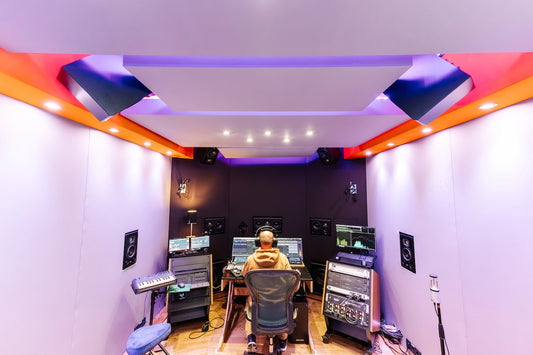
Headphones vs Studio Monitors: Choosing Your Audio Companion
When it comes to producing, mixing, and enjoying music, the choice between headphones and studio monitors can be a pivotal one. Both offer their own advantages and disadvantages and rely on other factors to maximise their effectiveness, making the decision not as straightforward as it may seem.
In this article, we break down the key factors to consider when deciding between headphones and studio monitors for your audio production needs.
Sound Isolation and Environment
Headphones for professional use tend to fall under two categories: closed-back, meaning the ear cups are sealed around your ears so that no external sounds can enter; and open-back, meaning the ear cups are open or perforated allowing some sound and ambient noise to pass through.
Closed-back headphones provide excellent sound isolation by creating a sealed environment around your ears, which makes it easier to focus on the intricate details of audio work, whether that be manipulating frequencies or recording an instrument. They are particularly useful in situations where external sounds can be distracting, like in a noisy home studio or a shared studio space.
Open-back headphones, like the HEDDphone, help reduce issues of sonic resonance within ear cups that can arise from using a closed-back pair. The result is a more open, spacious, and natural sound that is often favoured by audiophiles and professionals who prioritise true-to-the-source transparency in critical listening, mixing, or at-home enjoyment where ambient noise isn't a concern. However, this does mean that open-back headphones are not ideal if you have to work in noisy environments or shared spaces as both the ambient noise and what you’re listening to will leak into each other.
"For critical listening and the most natural sound reproduction, open-back headphones are the best solution."
There is a difference in how we experience sound between monitors and headphones, and that is because of how our auditory system works: in real-world situations our brain processes two separate streams, from each ear, and uses the differences between them to distinguish things such as direction or amplitude.
Studio monitors will physically push sound waves around a space and in that process these waves interact with objects (reflecting off them or being absorbed) creating shifts in timing and phase that allows our brain to understand volume and directional information in a way that feels much more natural. However, monitors also mean that the music can more easily travel through walls making them problematic if you’re working in close proximity to others.

Different Experiences
Listening on headphones results in both ears being fed their own channel (left and right) at precisely the same time, which often makes it seem as if the sound is coming from inside rather than around you. This will in turn result in your perception of the stereo image to differ – panning and spatial effects will take on new dimensional qualities – something that is less of an issue when listening on monitors.
As such, you will need to learn how to differentiate between what music sounds like on headphones versus monitors in order to properly account for these differences when engaging in detailed activities such as mixing. This is why many professional studios often work with both headphones and monitors, so that they can get the most out of both approaches.
Portability and Convenience
Portability is another key factor. Headphones are undeniably more portable and convenient for those on the go. Whether you're travelling, working in different locations, or simply need to keep your studio setup compact, headphones are a great choice.
Studio monitors often require a dedicated workspace and proper acoustic treatment of the room they’re used in. Some smaller form monitors, like the HEDD TYPE 05 and TYPE 07, provide a best of both worlds approach in that they can be more easily transported and quickly setup for different work environments.
Ear Fatigue
One often overlooked aspect is ear fatigue, which is a factor in the use of both headphones and monitors.
When you wear headphones for extended periods, the pressure on your ears and the proximity of the sound source can lead to listener fatigue. Studio monitors on the other hand may seem to create less fatigue at first but can still cause tiredness especially if there are issues with their setup or frequency response.
To mitigate ear fatigue, it's good practice to use a combination of both headphones and studio monitors and to remember to take regular breaks. This way, you can maintain a fresh perspective on your audio work.

Conclusion
Choosing between headphones and studio monitors ultimately depends on your specific needs and preferences. Both have their strengths and weaknesses, and the ideal setup might involve a combination of both to harness the advantages of each. Careful consideration of your workspace, acoustic treatment, and listening habits will help you make the right decision. In the end, the most important thing is to know your tools and how they affect your work.
Whichever path you choose, investing in high-quality headphones and studio monitors will elevate your audio production. If you would like advice on setting up your own studio then please get in touch.

